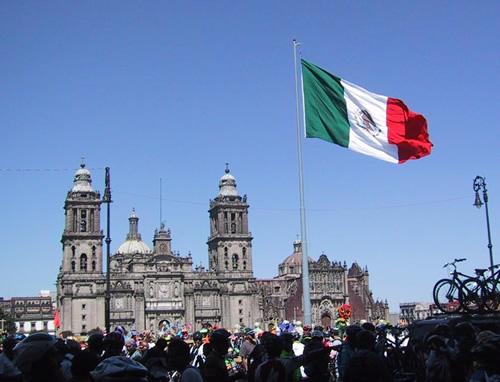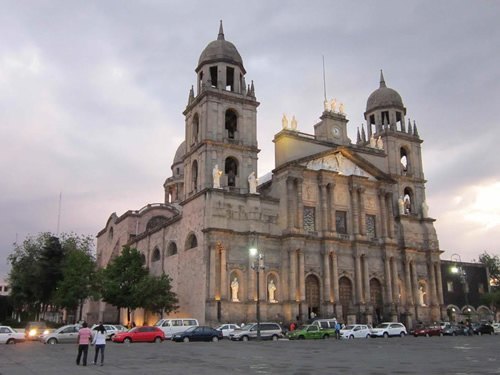How to Work Legally in Mexico
The Insider's Guide to Obtaining
a Visitor Visa for Work
Article and photos by Ted Campbell
Resources updated 9/17/2023

Zocalo in Mexico City with
Flag. |
The call from Mexican immigration came
in the late afternoon. My visa was ready. I could pick it
up the next morning.
I called my future director at the university
that had hired me. Classes were beginning that week, and
although they had already been assigned, it was important
to bring the visa right away in case something came up.
Three weeks earlier the university had
provided me with a letter so I could apply for the proper
permission at the Instituto Nacional de Migracion — the
National Institute of Migration, or INM. I applied right
away. True to their word, once I had finally fulfilled all
the requirements, the visa application process took three
weeks.
The job interview process had been time-consuming
and stressful. I translated my resume to Spanish and hit
the streets, getting lost on bus trips and sweating in my
cheap suit. My money was running out. You can read about
how to find a teaching job in Mexico in this
article I wrote for Transitions Abroad.
The small, well-restored INM building
was familiar to me now. I had made many trips over the last
few weeks — first to find out the requirements, then
to bring proof of payment, later to bring the things I had
gotten wrong the first time, later to bring even more. Now
I entered with confidence — despite my poor Spanish
ability, I figured I would just hand over the final payment
receipt and walk away with my work visa. So I signed in,
took a number, and took a seat.
I didn’t understand what the smiling
officer said when she finally called me up, but evidently
it wasn’t good. The visa wasn’t ready. Why?
Had I forgotten yet another document? Had I misunderstood
the phone call?
Eventually I figured out what she was
trying to tell me. The power was out, so they couldn't run the computers and card printer. Come back tomorrow.
The Visitor Visa
Formerly known as the FM3, the Mexican
work visa is officially known as the Visitor Visa with Permission
to Engage in Lucrative Activities (visitante con actividades
lucrativas). There are several long-term visas in Mexico,
including various Visitor, Temporary Resident and Permanent
Resident Visas. If you want to stay in the country longer
than what you were automatically given upon entering, you
should look
into these visas for Mexico and their specific requirements, which
include your reason for staying and available funds.
The Visitor Visa is card like a drivers license,
and it comes with an official-looking letter. The letter
explains which field you have permission to work in. As
a teacher my field is education. This means you can
have as many jobs as you want as long as they are in your
field, and anywhere in the country, not only in the state where you first applied for a job.

Cathedral in Mexico City. |
The First Requirement
The process begins outside the National
Immigration Institute. You need to get a job offer before
you can apply for permission to work. This is standard for
many countries.
Getting a job in Mexico (and later for
the application) requires a lot of documents. Before you
leave home, get and bring originals of your birth certificate
and anything that is relevant to your profession, like degrees,
titles and transcripts. One school even asked me for elementary,
middle and high school transcripts, which of course I didn't
have.
Make sure you keep copies at home, or
better yet take digital photos, in case something gets lost.
Once a company wants to hire you, they
will provide you with a letter stating their intention and
relevant details, such as your activities, the duration
of the job and how much you will be paid. Make a copy and
include it with your application. The company must also
provide a “proof of registry,” permission from
the government to hire foreign workers. Unless you will
be their first foreign worker, they should know exactly
what to give you.
2016 Update: Although I was able to process my visa in Mexico, apparently this has changed, and you must now do it at a consulate outside of Mexico. It’s a Catch-22: You need to come to Mexico for the a job, where it’s practically impossible to get hired by email, but you need to leave Mexico for the visa.
But regulations change quickly, and exceptions may be possible, so I recommend that you first visit a Mexican consulate in your home country. Then, once in Mexico with your job offer, before flying to another country to process the application, visit the nearest INM office for the final verdict.
Other Requirements
Requirements change with little or no
notice, and not only in Mexico. In the summer of 2009 Canada
began requiring travel visas from Mexicans (and Czechs,
incidentally) for the first time. People with plane tickets,
hotel reservations, and tours already booked formed massive
lines at the Canadian embassy in Mexico City.
Keep in mind that any information you
find online may be either out of date or confusing. You
will have to go to the INM a few times anyway, so on your
first visit ask for a list of requirements.
Remember to bring originals of all the
items below. Once in Mexico you might be asked to have official
copies (apostilles) made, for the visa application
or even for your job. Apostilles are typically cheap and easy to get — at least in the U.S. — but of course it’s easier to do back home before you leave. Google “apostilles” and the name of your state, and check the information on the Secretary of State website, not on third-party websites that offer to do it for you.
- Birth Certificate
- All degrees/titles/certifications
and transcripts from universities or other relevant schools.
- Your passport — they may want
copies of every page or just the photo page. Remember
to ask.
- The little immigration paper you
filled out when you entered Mexico. It will say how many
days you are allowed to stay. When you get the visa,
they won’t return it, but if for some reason you
are denied, make sure you get it back. Without it you
will pay a fine when leaving Mexico.
- The application printed only a day
or two before. Go
here for the Instituto Nacional de Migracion (National
Immigration Institute) website. At the time of writing,
only the home page is in English. To start the application,
go to this
page and then enter your data.
- Infantil size photos — the
size of most drivers license photos. Immigration should
have a spec sheet. Many immigration offices have a photo
shop nearby.
-
Two payments — one when you
apply and one when you pick up the visa. Get the forms
from the office. You can pay at any bank — bring
cash and your passport. When I applied it was 500 pesos
with the application and 2,000 when it was ready, but
like everything else, expect this to change.
More documents may be necessary, such a comprobante de domicilio (proof of residence), which is usually a telephone, electricity or water bill that shows your address. And don’t forget the letter
from the company that wants to hire you.
And finally, an essential thing to bring
to the National Institute of Migration office is plenty
of patience.
The Strategy
Be patient, calm, and reasonable at
all costs. You may have to go more times than you want.
You may be given different information each time. Just smile,
write it down, and do what you can. If you can’t provide
something, just come back without it and don’t mention
it. In the friendliest way possible keep mentioning the
letter from your future company. If you get angry and show
it, you will get nowhere.
Before the FM3 was a little book full
of stamps, like a passport. You could only work at the job
that provided the letter and only in that state. The application
process could take months.
Now there is a reasonably straightforward
website, a much shorter wait time and simplified requirements.
In the INM office I visited there was a big sign in Spanish
stating that it isn’t necessary to hire a lawyer to
apply for visas. The staff was always polite and patient,
even when the place was packed or the power was out.
Nevertheless, Mexico is full of bureaucracy
and red tape. The need for calm doesn’t only apply
to immigration, but to any dealings with official people,
especially government. This goes for work, banks, border
crossings, police, and any other government agency. Watch
how Mexicans deal with unreasonable situations — they
don’t get mad and loudly complain. They shrug and
say ni modo — it can’t be helped.
And this doesn’t only apply to
Mexico, but to any country with a different language and
culture from yours. A misunderstanding is always the foreigner’s
fault — even when it isn’t.
Life With The Visitor Visa
With the Visitor Visa (with lucrative
activities) you will receive social insurance, including
health care, and you need to go to another office to get
the number. Also, you don’t have to pay Mexico’s
entry fee anymore, which at the time of writing is 295 pesos,
around 25 dollars. This is automatically added to plane
tickets, so when purchasing make sure they know you have
the Visitor Visa.
Starting Work
I had been frustrated so many times
during the visa application process that I wasn’t
surprised when the officer told me the power was out. I
just shrugged and thanked her. There was no reason to ask
why they had called to tell me it was ready, even though
it wasn’t really ready. I found out the answer the
next day — I had to sign a form for the card before they could print it.
The next morning the office was quiet
and they attended to me right away. The copier and printer worked. They took my fingerprints and payment receipt and
gave me the card and letter. I walked out and immediately
called the university.
“You have the visa now?”
“Yes.”
“In your hand?”
“Yes, I just got it.”
“Can you be here in 30 minutes?
I think I have a class for you.”
I flagged a taxi and got to the school
in 27 minutes, planning a class in the backseat, scribbling
notes on the backs of unused copies of my passport. How
many students? What’s the schedule? And what level
of English?
The school was full of activity, the
first week of the summer session. Teachers bustled about
with stacks of books in their arms, while students searched
for the correct classroom and greeted friends. I walked
upstairs to the offices and talked to the head of the languages
department.
A teacher had not shown up and I was
getting his class. I handed over the Visitor Visa card and
the official letter. We hurried to human resources. Yes,
everything seemed to be in order.
Only about 15 minutes late, I found
the right class and entered a big, noisy room of 30 university
students, thus beginning my teaching career in Mexico.
 |
Ted Campbell is a freelance writer, Spanish-English translator, and university teacher living in Mexico.
He has written two guidebooks (ebooks) about Mexico, one for Cancun and the Mayan Riviera and another for San Cristobal de las Casas and Palenque in Chiapas, both also available at Amazon.com or on his website.
For stories of adventure, culture, music, food, and mountain biking, check out his blog No Hay Bronca.
To read his many articles written for TransitionsAbroad.com, see Ted Campbell's bio page.
|
|
